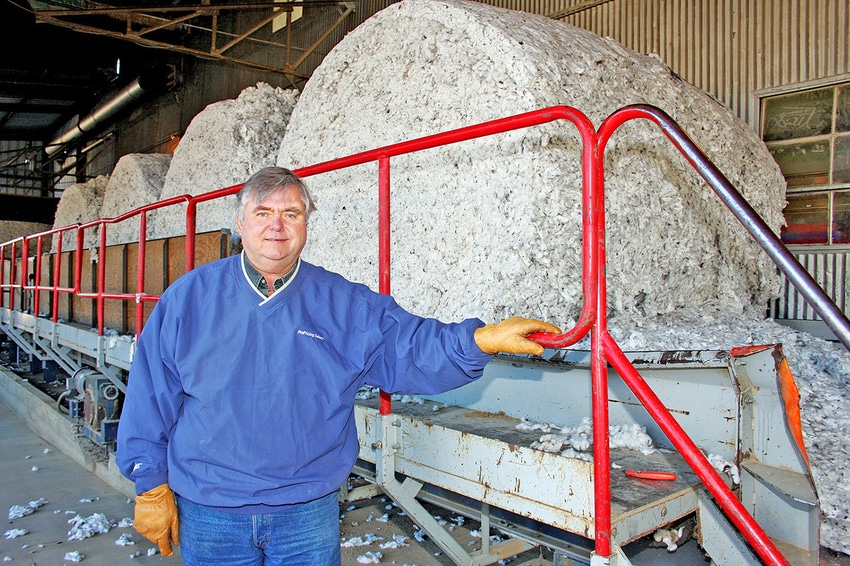March 22, 2015

The boll weevil, now eradicated in most of the U.S. Cotton Belt, was the reason Holt Shoaf’s family returned to Tennessee nearly 100 years ago. Originally from the Volunteer State, Shoaf’s grandfather, Richard Barrett “R.B.” Shoaf, ran the compress at Port Gibson, Miss. The boll weevil hit that area really hard, but it had not invaded Tennessee at that time.
“So in 1919,” Holt explains, “the compress owner, R. L. Taylor — he founded Federal Compress & Warehouse Company — had my grandfather dismantle the press at Port Gibson and take it by railroad to Milan, Tenn., and build a new compress.”
Shoaf, 2015 president of the Southern Cotton Ginners Association, says, “My father, John A. Shoaf, was two years old at the time. My grandfather remained manager at the Milan compress until he retired in the 1950s. And that’s how we ended up in Milan — because Tennessee didn’t have the boll weevil!”
Shoaf’s family has been involved in cotton warehousing since the early 1900s, and in ginning since the early 1950s.
“At one time or another, my father and some partners owned 25 to 30 gins,” he says, “but not that many at the same time.” Shoaf, who farms and gins with his brothers, Hedrick and Vance, says, “Most of those gins were small plants that ginned 2,000 to 3,000 bales in a good year. Over the years, we consolidated several gins into bigger ones, and closed the smaller ones. The Sonic Drive-In at Ripley, Tenn., now stands on the former site of one of our gins.”
Four gins today
Today, the Shoafs are involved in four gins. They completely own the L&H Gin Company at Alamo, and are partners in the other three gins: Cairo Farmers Gin, in Crockett County; Farmers Gin of Humboldt at Humboldt; and Yorkville Gin at Yorkville.
The four gins feature modern equipment for efficient operation. For example, the L&H Gin Company has three Lummus 158 gin stands, with Lummus 700 extractor feeders.
“We have the ability to do three stage lint cleaning, if we need to,” Shoaf says. “We gin our own cotton and our customers’ cotton to make the most money. About 15 years ago, cotton merchants pushed for single stage cleaning. Then later, they wanted cleaner cotton. We have the ability to gin for the market.”
The L&H Gin handles both round modules and conventional modules, while the Cairo Farmers Gin handles almost exclusively round modules.
The Shoaf family has been involved in several segments of the cotton industry for a long time: compress, warehouse, ginning, merchandising and farming.
“Cotton has always been our family’s main crop,” Shoaf says. “We’ve seen fluctuations in cotton acreage and cotton prices over the years. Just as it has in the past, the cotton industry will come out of the current price/acreage slump. And when the price comes back, acreage will come back, just as it always has.
“Even though cotton acreage will be down in 2015, it won’t collapse. For this coming season, cotton pencils out better than corn, for sure. I feel confident that Tennessee will continue to maintain its ginning and cotton production infrastructure.
Ginning infrastructure
“West Tennessee’s ginning infrastructure hasn’t been affected by the infrastructure problems experienced in other areas of the Mid-South. Tennessee gins generally have continued unchanged through the corn and soybean boom.”
But, he quickly notes that even though gins and cotton farming will continue, the infrastructure probably will evolve.
“The cotton industry continues adapting to change,” he says. “Just like our family once owned many small gins, those that became inefficient were consolidated or closed.
“In 1983, Tennessee had 220,000 acres of cotton, and expanded to 700,000 acres in 1995 and 2006. Gins closed in the state every single year that cotton acreage was booming. Some were obsolete, some had poor management, and the bigger and faster gins just took over. That trend will continue — the more efficient operations will stay in business, and the least efficient won’t.”
Long-time SCGA members: The Shoaf family has been members of the Southern Cotton Ginners Association (SCGA) ever since it was founded in 1967. Predating that, they have been members of the Tennessee Cotton Ginners Association.
“One of the big benefits of belonging to SCGA is the people you get to know — farmers, ginners, and state regulators,” Shoaf says. “You meet some great people, and get to exchange ideas with them. Another big advantage of belonging to SCGA is its safety program, which saves us a lot of money on workman’s comp insurance, and helps keep our ginning crews even safer.
“And, of course, you can’t beat the association’s annual Mid-South Farm and Gin Show in downtown Memphis. I remember, as a kid, my parents going to the show when I didn’t even know what the Gin Show was. The show has really expanded over the years. In addition to providing ginners and farmers a firsthand look at innovative products, equipment, and services, it offers exceptional educational programs, such as its Ag Update Seminars.”
You May Also Like




